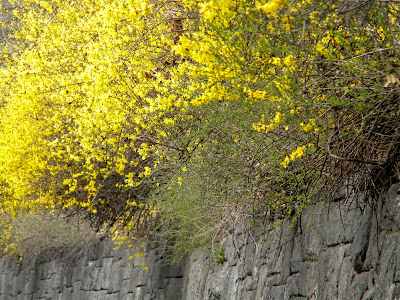The forsythias, coming from China and Japan, belong to the order Oleacece, and have long been in cultivation in English gardens, the name of the genus having been applied in the last century, in honor of William Forsyth, the king's gardener at Kensington for many years. There are but few species or varieties known to us in cultivation, but all that are thus employed prove to be charming plants, and of especial worth because of their season of flowering and the situations which they may be made to occupy to advantage. The flowers are solitary, bright yellow, and very numerous, and so distributed along the branches as to often cover the entire bush.
These are produced on the wood of the previous year's growth, and it sometimes occurs that people who do not appreciate this fact prune their plants in winter, thus removing nearly all the flowering wood, and then complain that their forsythias do not meet their anticipations. These plants need to be severely cut back each year, but it should be done at the close of their flowering season, which is before the foliage fully puts out rather than after. Nearly all the wood of the year preceding should be cut away, and the knife may be used without fear of doing harm, as new branches will quickly take the places of those removed.
All the forsythias are rapid growers, and the long, slender branches, newly formed, carry foliage sufficiently attractive to justify the highest expectations in seeking a desirable plant of its proportions. When occasion requires, the shrub may be trained on a wall or fence and made to cover a considerable space. It is equally fitted to be formed into a round, compact head, as is often done in the best gardens.
 | Image License: I, (sookietex) the creator of this work, hereby release it into the public domain. This applies worldwide. In case this is not legally possible, I grant any entity the right to use this work for any purpose, without any conditions, unless such conditions are required by law. If These image is subject to copyright in your jurisdiction, i (sookietex) the copyright holder have irrevocably released all rights to it, allowing it to be freely reproduced, distributed, transmitted, used, modified, built upon, or otherwise exploited in any way by anyone for any purpose, commercial or non-commercial, with or without attribution of the author, as if in the public domain. |
F. veridissima takes its specific name from the bright green leaves which it carries, rather than from the color of its flowers, which are golden-yellow and among the first to appear in spring. This is the plant longest and best known in our gardens, and the species which drew so many praises from flower-lovers a hundred years ago and which were by no means unmerited. It is of erect, spreading habit, and entirely hardy.
F. suspensa differs but little from the other form, except that its long, slender branches are slightly pendant at their terminals, and so are by many esteemed more graceful. The blossoms may not be quite so numerous, but the plant as a whole is fully as good, though not especially to be preferred except for training on walls or trellises where it will have a wider spread. A correspondent in Medians Monthly gave an account, some time since, of an instance where a plant was kept to a single stem for ten feet, and then allowed to spread on the trellis, where it did good service by way of affording shade to a doorway which was too sunny an exposure. This illustrates its capabilities in that direction.
The plant is sometimes catalogued under the names F. fortunei and F. sieboldi, but these are to be regarded merely as synonyms.
TEXT CREDIT: Ornamental shrubs for garden, lawn, and park planting














No comments:
Post a Comment